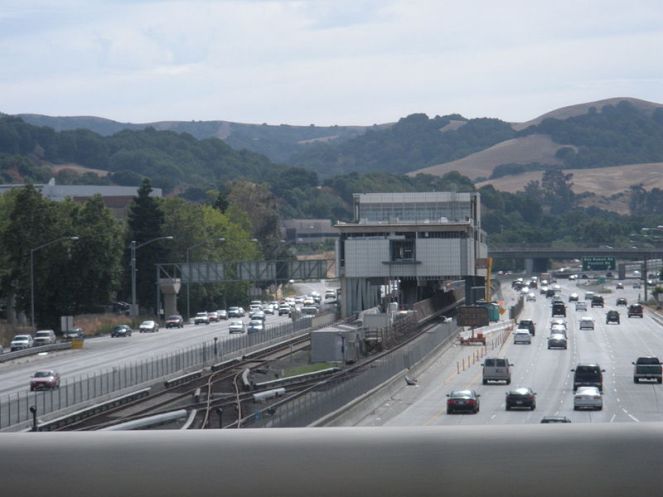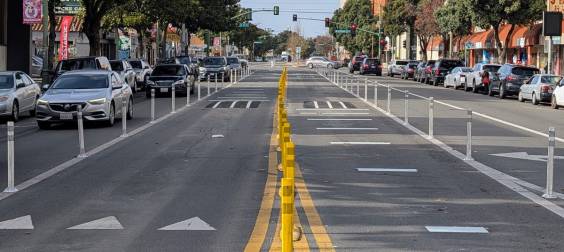Tomorrow, Thursday May 24th, at 4 p.m., the BART Board of Directors is scheduled to vote on whether or not to move forward on a 5.5 mile extension of the Dublin/Pleasanton line from its current terminus to a new freeway median station at the Isabel exit on I-580 (the Board Agenda can be downloaded here.)
Thus far, the debate among the directors has centered on a familiar theme--whether to spend precious dollars on maintaining and increasing capacity on the core system, or build another multi-billion dollar extension.
Perhaps that's a valid debate to have, but in this case, it's not necessary to go there.
If BART had enough money in its pocket, right now, to build another Transbay Tube, a line under Geary, and even an extension across the Golden Gate Bridge to Marin, and still had $1.6 billion leftover for the Livermore extension, the plan that's on the table would still be an absurd proposal that misses the whole point of regional rail.
BART is not a commuter train. It's also not a subway system. It's a regional rail system, akin to the Paris RER or Germany's S-Bahn. Those are characterized by a trunk line through the urban core (the Market Street subway in BART's case) where service is fast and frequent, with lines that branch out to the suburbs. In the urban core, regional rail systems need multi-billion dollar tunnels and viaducts, so trains can run fast and frequently. In the suburbs, trains branch onto much cheaper, at-grade lines that, in some cases, are shared with freight and long-distance trains. On the branch lines, train service is regular but less frequent. Sometimes the branch lines are even single-track.
By focusing investment on the core system, everyone benefits, since all lines use it. It also allows the system to spread far and wide and serve the maximum number of people, since the trains can take advantage of existing rights of way in outlying regions.
At least, that's how regional rail is supposed to work.
Unfortunately, the legacy of BART's non-standard-gauge trains makes it impossible for trains to fan out onto other rail systems when they leave the city center. That's why we have the Warm Springs/San Jose extension with hundreds of millions of dollars worth of viaducts over empty fields. That line at least has the major job center of San Jose as its destination to justify its costly existence.
So how should BART move forward to be a successful regional rail system, given the huge constraint of its incompatible, wide-gauge trains?
The answer is obvious: BARTs extensions should get to the nearest logical transfer station to conventional rail, so that passengers who are headed farther out of San Francisco and Oakland can transfer and continue on their way.
BART has built this kind of end-of-line transfer station on the Richmond Line, with the transfer to Amtrak's Capital Corridor trains to Sacramento and the Central Valley. It's also done it at Millbrae, with the connection to Caltrain. The connections don't currently work very well, but, one hopes, the long term goal of establishing timed transfers and unified ticketing will make them more seamless.
These end-of-line transfer stations, by the way, work better if they are put someplace that is a destination in itself, such as downtown Livermore and/or the Livermore Labs.
And that was actually the plan for the Livermore BART extension until 2013--to have BART leave the freeway median and go to downtown Livermore for a transfer to the Altamont Commuter Express train, which runs between the Central Valley and San Jose. The old plan actually had a second ACE/BART transfer station at Livermore Labs, so BART riders wouldn't have to transfer to get to work.
But the mayor of Livermore and the City Council rejected it, in favor of continuing the line in the center of I-580, after they were cowed by constituents who reportedly feared a train to downtown would "damage the city’s historic character." Translation: they didn't want a BART train going by their houses.
So Livermore decided the parochial interests of a couple of thousand NIMBYs should trump the interests of the millions of people who live and work in the Bay Area. If the extension is approved as currently planned, it means that someone who wants to take the Altamont Commuter Express train and transfer to BART would still have to take a bus to make that connection. It means someone who wants to take BART from San Francisco or Oakland to Livermore would still have to transfer to a bus in the center of the freeway to get there. Furthermore, it means widening I-580, since there's no freeway median available for BART to run in--the soon-to-open Antioch extension notwithstanding, the availability of an existing median is the only argument for ever running trains in the middle of a freeway.
The BART board vote seems to be falling along familiar lines, with representatives from San Francisco and Oakland likely to vote against the extension and the suburban reps leaning in favor. The wild card is Bevan Dufty, who represents BART for parts of San Francisco, including the Mission. The last time Streetsblog spoke with him, he wouldn't commit for or against. Dufty and, word has it, BART District #7 Director Lateefah Simon, who represents parts of San Francisco, Oakland, and a few other cities, could both benefit from a few calls encouraging them to advocate for improved bus connections from the end of the Dublin/Pleasanton Line instead of extending the rails under the current plan.
Meanwhile, supporters of the BART-to-the-Isabel-exit extension are using the tired argument that Livermore residents pay taxes and therefore deserve the extension they want.
Everyone pays taxes. That doesn't give Livermore the right to burn $1.6 billion on an extension that maximizes costs and minimizes utility for the whole region.
Streetsblog readers, especially those who live in BART District 9 (the Mission, Glen Park, Civic Center, Powell Street, Balboa Park) should contact Director Dufty prior to tomorrow/Thursday afternoon to let him know how they feel about this extension. It would be a good idea to contact Lateefah Simon if you live in her district. Or contact them both if you're not sure.
Or come speak at tomorrow's BART board meeting, 4:00 p.m. on Thursday, May 24, 2018, in the BART Board Room, 2040 Webster Street, Oakland.






